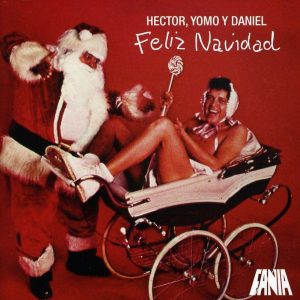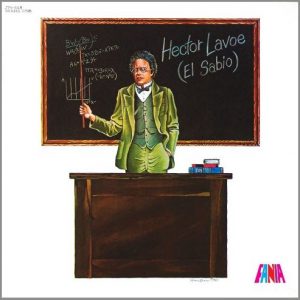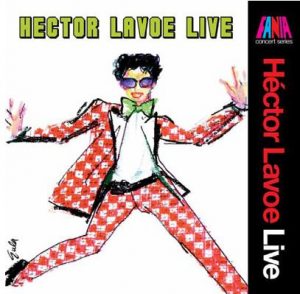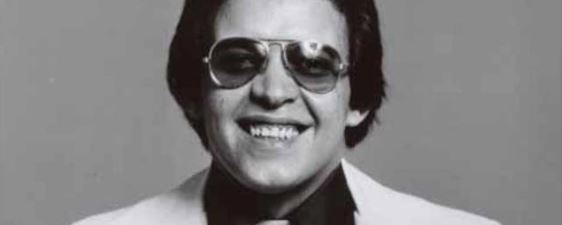This post is also available in:
 Español
Español
In the first two parts on this series on Hector Lavoe I wrote about his work with Willie Colon (Part 1), and the early part of his solo career (Part 2).
In this part I’ll share with you how I see Hector’s work towards the latter part of his career. This later part of Hector Lavoe’s career was characterized by albums with one or two good songs, but no great albums.
Two Themed Albums; Christmas Salsa and Boleros

From his later production of Hector Lavoe’s career, probably the best remembered was the first one from this period. Perhaps it’s because it continues the pattern of his 4th best album being the 4th one he released as a solo artist.
The album “Feliz Navidad” had a few good numbers but does not compare in quality with any of his two “Asalto Navideño“ albums recorded with Willie Colon. “Feliz Navidad” had as guest artist the legendary Puerto Rican singer Daniel Santos. It also featured Yomo Toro on the Puerto Rican “cuatro” guitar. Yomo obviously provided the album with the Christmas touch.
The album has a few good songs, and although there are better Salsa Christmas albums than this one, I would recommend that you buy this one only after you get some of the better ones. Overall it’s a good album, although not great.
“Recordando a Felipe Pirela” is a bolero only album which Hector Lavoe recorded in 1979 after “Feliz Navidad”. In it he honored the Venezuelan singer who was one of the best bolero singers in Latin America. The hit single “Sombras Nada Mas” although a good song, never appealed to me. Therefore, this ended up being the only Hector Lavoe album I don’t have, nor am I interested in owning.
Hector Lavoe Last Four Studio Recordings
The next four studio recordings of Hector Lavoe are nothing to write home about. All albums have some good Salsa songs which make them worth buying if you’re an Hector Lavoe fan like me. However, none of the good songs were spectacular hits and the albums lacked quantity of good songs.

The album “El Sabio” had the title song as the best song of the album. It’s actually a very good song, where Hector and the band perform the late Tito Rodriguez hit with a very aggressive arrangement. I was waiting for more aggressive Salsa in the album. However, only “Para Ochum” comes in a distant 2nd place in terms of quality of the song.
“Que Sentimiento” is an album that only inspired a “sentimiento” of disappointment. The bomba “Lo Deje Llorando”, the old hit from Cortijo and Ismael Rivera, is perhaps the best song. In it Hector showcases some of the humor in the “soneos” that was his trademark.
“La Fama”, written by Hector Lavoe, was the most popular song of the album “Revento”. It is a good song, and has more meaning as Hector shares his frustrations with the fame that he acquired. However, my favorite song of the album is “Dejala Que Siga”, perhaps because its happier and Lavoe again sprays humor into the song.
Finally, “Strikes Back” was Hector’s final studio album. The best song of this one is “Ponce”, which is dedicated to his hometown in Puerto Rico. I really like this song a lot and would think it should have been the closest to a mega-hit in these last 4 albums. Although it became popular, it did not reach mega-hit status.
Here’s a video of Hector Lavoe performing “El Sabio”. However, it has an overdubbing of the original recording audio, which is much better than the audio in this live performance.
Hector Says Goodbye with “Live”

A collection of songs from these 4 albums would produce a very nice album, as there are good songs in all four albums. But as said, all albums lack the depth of good songs needed to make the recording worth the money spent.
One album released after Hector’s death was “Hector Lavoe Live”, which was recorded in a New York club during a Hector Lavoe show. This recording not only has a good collection of his hits, but more importantly, captures Hector in a “live” performance, where you see his wit, charm, singing, and his band expanded arrangements on some songs.
The music of Hector’s orchestra is at a good point when he did this performance. The sound quality was quite decent, considering it may not have been intended for a recording. And Hector’s voice and char is still great. This one I highly recommend you add it to your collection.
Next: Hector’s work with the Fania All Stars
My next blog of the series will be of the work Hector Lavoe did with the Fania All Stars. He recorded some great things with them, and is worth covering as an epilogue to this series. Stay tuned to Latino Music Cafe for that one.
If you haven’t read the first two parts of this series, you can check Part 1; the Willie Colon Years and Part 2; Early Solo Career at the hyperlinks included.


Hello, Mr. Aviles. I just found out about your site. Great stuff! In regards to your article on Willie and Hector, I commend you. It was well done, especially the way you break it down into three “phases” of their brilliant careers. I grew up in the South Bronx, not far from where Willie lived. Just a few comments on some of your observations: you mentioned that in their early years, they embraced the “boogaloo” that was, as you know, immensely popular at the time. However, I must disagree. Only El Malo had several “boogaloo” tunes, The Hustler had one, and Guisando had one, so I don’t think that makes then jumping on the band wagon. As we all know, Mr. Colon has an unbelievable original mind, and I believe he had already made up his mind on what direction Hector and him were going in 1968 with the release of The Hustler. In the song, “Eso Se Baila Asi”, he even states it; “boogaloo no va’ conmigo.” That was incredible!! To continue, you stated that Hector co-wrote several songs with Willie in “Lo Mato” Actually, he only contributed on one, “El Dia de Suerte.” (although Hector was an incredible lyricist.) In the landmark album “The Good, The Bad, and The Ugly”, Willie only sang one song, (Toma), since he was taking singing lessons at the time, but that album highly impressed me. It was innovative and fearless. On a final note, Willie had fired Hector many times for not being dependable. But his desire to semi-retire was not because of Mr. LaVoes’ antics, but it was about the violence he continually encountered at the clubs. He stated that too many times, there would some guy looking to challenge him because of his reputation. Somebody always wanted to kick “El Malo’s” ass. Anyway, he quit for a time and left the band to Hector. Well, I’ve been rambling for a while now. I’ve been living in Las Vegas for 40 years and I don’t have an opportunity to talk about this stuff very often. Keep up the good work, and I’ll be checking out your stuff from now on. Cuidate, y que viva la raza!!!
Saludos Juan!
First of all, call me Hector (Mr. Aviles was my dad).
Also, thanks for contributing with your comments. They are great comments all around. This is how we all learn a little more about our Latin music. I share what I know (I was born and raised in Puerto Rico, so my experiences and points of view are different from yours born and raised in the Bronx, and ours will be different than others born and raised somewhere else), and others share what they know.
I obviously heard a different version of why Willie and Hector split, but I take your word since you were closer to the action.
There’s one little point I do disagree with you. In “The Good, The Bad, and The Ugly”, Willie actually sang 3 songs (“Toma”, “Cua Cua Ra, Cua Cua”, and my favorite of the three, “Guaracha”).
More good stuff to come in Latino Music Cafe. Thanks for following! (we also have a Facebook page).
Felicidades!!!
Note: I think you’ll enjoy the blog series on Salsa History, The History of El Gran Combo, and the Reinassance of Bomba y Plena.